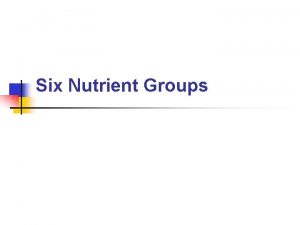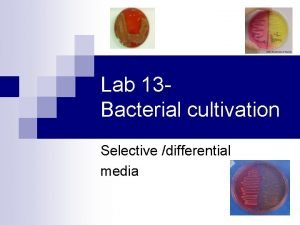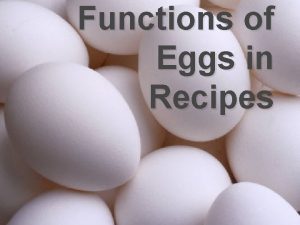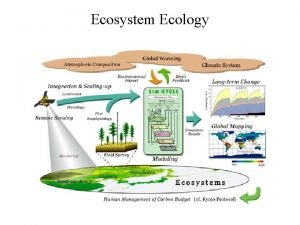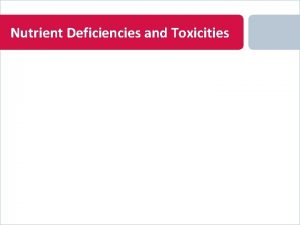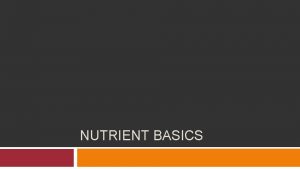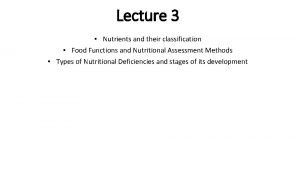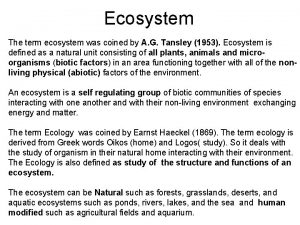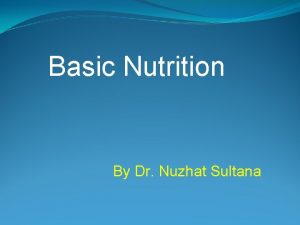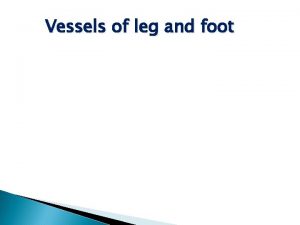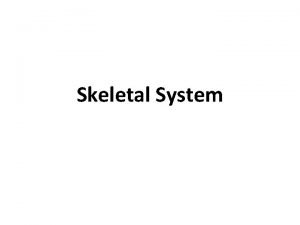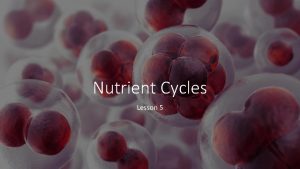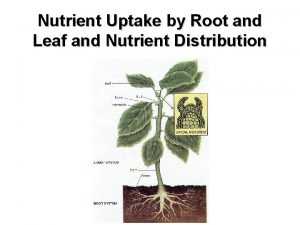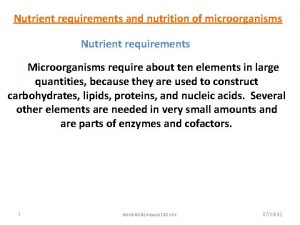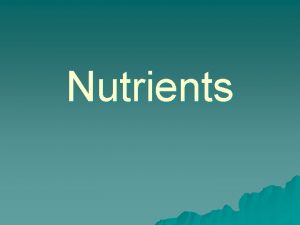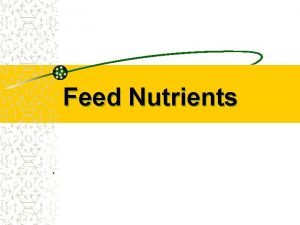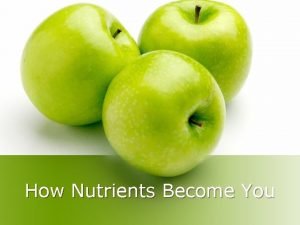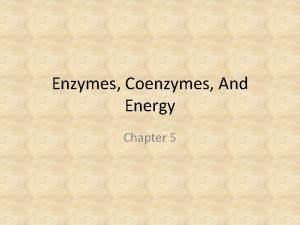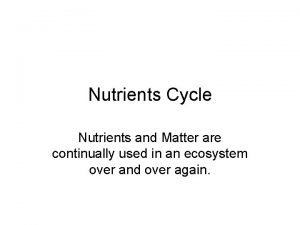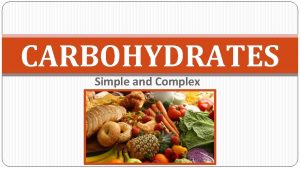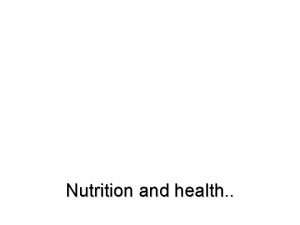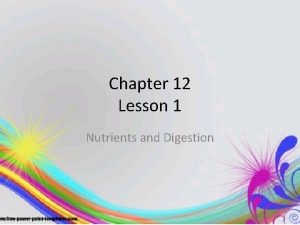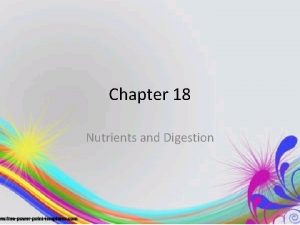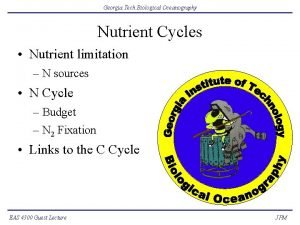Introduction to nutrients What is a nutrient and





















- Slides: 21

Introduction to nutrients What is a nutrient and why are they important? Components in foods that build and repair tissues, regulate body processes, and are converted to and used for energy. Nutrients fall into two main categories: macronutrients, that we need in larger amounts; and micronutrients, which are mostly needed in smaller amounts.

Macronutrients • Make up the bulk of our diet • Mainly involved in the supply of energy, also known as calories • Also a source of heat Macronutrients include: -carbohydrates -proteins (including essential amino acids) -fats, or lipids (including essential fatty acids) -water

Energy • We need energy for everything we do: -digesting our food -keeping our body tissues working like use our muscles, control our temperature, grow and make new tissues. • Energy is released from carbohydrates, proteins, fats by a process called oxidation. • The unit of energy is the kilojoule (k. J). -fats yield 37. 7 k. J/g -proteins 29. 3 k. J/g [1] -carbohydrates 16. 7 k. J/g

Micronutrients • Substances we must get in small quantities from our diet (either because we can’t make them for ourselves or because we can't make them as fast as we need them) • Not used as energy sources, but are necessary to process energy so our cells can use it. • Help regulate bodily functions Micronutrients include • vitamins • minerals

Energy requirements • Our personal energy requirements vary with age, gender, body size and activity • There are different recommendations of how much energy is needed every day for each age and gender group. Source: NRV NZ and Australia, 2005 Men Sedentary k. J Moderate k. J 19 -30 years 10, 800 13, 800 31 -50 years 11, 000 16, 100 51 -70 9, 500 12, 100 70+ 7, 400 13, 600 Women Sedentary k. J Moderate k. J 19 -30 years 8, 100 10, 500 31 -50 years 7, 900 10, 100 51 -70 7, 600 9, 600 70+ 7, 100 9, 100

Macronutrients – carbohydrates Major source of energy Simple carbohydrate • Simple sugar, white flour, honey, yogourt, milk • Two types of simple carbohydrates: monosaccharides and disaccharides • Monosaccharides consist of only one sugar (fructose, galactose and glucose) • Disaccharides consist of two chemically-linked monosaccharides (lactose, maltose and sucrose) -raise blood sugar level rapidly, short duration of energy • • • Complex carbohydrate made up of three or more sugars, linked together to form a chain found in vegetables, whole-meal bread and cereals rich in fiber, vitamins and minerals Two categories: oligosaccharides and polysaccharides. Oligosaccharides consist of a small number of monosaccharides (important in the absorption of certain minerals and the formation of fatty acids) Polysaccharides are made up of a large number of monosaccharides and disaccharides. Examples of polysaccharides include cellulose, dextrin, glycogen and starch -higher nutritional value than simple carbohydrates -take longer to digest, and don't raise the sugar levels in the blood as quickly as simple carbohydrates. -act as the body's fuel, and contribute to energy production.

Macronutrients - Proteins • Proteins are large molecules consisting of amino acids • All foods made from meat, poultry, seafood, beans and peas, eggs, processed soy products, nuts, and seeds are considered part of the protein foods group. -help build tissue -involved in growth, repair and replacement tissue and cells -important in building immune system (helps transport oxygen)

Macronutrients - fats • Fat is a nutrient that is essential for normal body function. It supplies energy • 3 types of fats trans, saturated and unsaturated • Trans fats are synthetically made, they do not naturally occur. They are created in an industrial process that adds hydrogen to liquid vegetable oils to make them more solid. (also known as partially hydrogenated oils). • Saturated fats are animal fats - butter, lard, cream, fat in (and on) meats. • Unsaturated fats are liquid fats and there are 2 types : monounsaturated and polyunsaturated

Unsaturated fats Monounsaturated • fat molecule has only the space for one hydrogen atom • Found in olives, ground nut oil, and avocados Polyunsaturated • Found in oily fish (sardines, mackerel, trout, salmon and herring), safflower oil, grapeseed oil, and sunflower oil.

Micronutrients • Needed in small amounts compared to macronutrients, however if not consumed may cause serious health issues • Include minerals and vitamins • vitamins are organic substances (made by plants or animals), minerals are inorganic elements that come from the soil and water and are absorbed by plants or eaten by animals. • Are vital to proper functioning of body

Minerals Purpose calcium -proper muscle contractions and strengthens bones -helps with blood clotting -helps nerves transmit information chloride (sodium) -helps regulate water and electrolytes within your cells, as well as helping to maintain appropriate cellular p. H iodine helps your thyroid gland develop and function. It helps your body to metabolize fats, and promotes energy production and growth iron -helps your body produce red blood cells and lymphocytes magnesium -helps your heart maintain its normal rhythm -helps your body convert glucose (blood sugar) into energy, and necessary for the metabolization of calcium and vitamin C manganese -promotes bone formation and energy production, and helps your body metabolize the macronutrients, protein, carbohydrate and fat potassium -helps with proper function of cells, tissue and organs -normalize digestion and muscle function (contraction) -plays a role in cell division, cell growth, wound healing, and the breakdown of carbohydrates -helps the immune defence system zinc

Vitamins • Vitamins fall into two categories: fat soluble and water soluble. • The fat-soluble vitamins — A, D, E, and K — dissolve in fat and can be stored in your body. • The water-soluble vitamins — C and the Bcomplex vitamins (such as vitamins B 6, B 12, niacin, riboflavin, and folate) — need to dissolve in water before your body can absorb them.

Fat soluble vitamins • Needed in small amounts • Will not be lost when the foods that contain them are cooked • Stored by the body in the liver and fat tissue • Too much of these vitamins may be toxic

Fat soluble vitamins and functions Vitamins Function Vitamin A -also called retinol -helps eyes adjust to light levels -important role in bone growth, tooth development, reproduction, cell division, gene expression, and regulation of the immune system -helps skin, eyes, and mucous membranes of the mouth, nose, throat and lungs stay moist Vitamin D -helps with absorption of calcium for strong teeth and bones -helps with control of cell growth, maintenance of immune system Vitamin E -acts as antioxidant -protects vitamins A and C, red blood cells, and essential fatty acids from destruction Vitamin K -helps with normal blood clotting, promotes bone health, and helps to produce proteins for blood, bones, and kidneys

Fat soluble vitamins and their food sources Vitamins Food and other sources Vitamin A -foods of animal origin such as dairy products, fish and liver -some foods of plant origin contain the antioxidant, betacarotene, which the body converts to vitamin A -beta-carotene, comes from fruits and vegetables, especially orange or dark green Vitamin D -dairy products -oily fish (herring, salmon, sardines) -sunlight Vitamin E -vegetable oil (soybean, corn, cottonseed, and safflower) -fruits and vegetables, grains, nuts (almonds and hazelnuts), seeds (sunflower) and fortified cereals Vitamin K green, leafy-vegetables such as turnip greens, spinach, cauliflower, cabbage and broccoli -certain vegetables oils including soybean oil, cottonseed oil, canola oil and olive oil.

Water soluble vitamins • Water soluble vitamins are C, B-complex and folic acid • Water-soluble vitamins travel freely through the body • Excess amounts usually are excreted by the kidneys • The body needs water-soluble vitamins in frequent, small doses • Citrus fruits are good sources of vitamin C • The B-complex group is found in a variety of foods: cereal grains, meat, poultry, eggs, fish, milk, legumes and fresh vegetables

Water soluble vitamins and functions Vitamin C Function -also known as ascorbic acid -holds cells together through collagen synthesis; collagen is a connective tissue that holds muscles, bones, and other tissues together -aids in wound healing, bone and tooth formation, strengthening blood vessel walls -improves immune system function -acts as an antioxidant Biotin -helps release energy from carbohydrates and aids in the metabolism of fats, proteins and carbohydrates from food Folic acid -aids in protein metabolism -promotes red blood cell formation -lowers the risk for neural tube birth defects -helps reduce the risk for coronary heart disease

Water soluble vitamins and functions continued… Vitamins Function Vitamin B 1 -also know as thiamin -helps to release energy from foods, promotes normal appetite, and is important in maintaining proper nervous system function Vitamin B 2 -also known as riboflavin helps to release energy from foods, promotes good vision, and healthy skin Vitamin B 3 -also known as niacin -involved in energy production, normal enzyme function, digestion, promoting normal appetite, healthy skin, and nerves Vitamin B 6 -aids in protein metabolism and red blood cell formation -also involved in the body’s production of chemicals such as insulin and hemoglobin Vitamin B 12 -aids in the building of genetic material, production of normal red blood cells, and maintenance of the nervous system

Water soluble vitamins and their food sources Vitamins Food and other sources Vitamin C -citrus fruit, kiwi and sweet red pepper Biotin -liver, kidney, egg yolk, milk, most fresh vegetables, yeast breads and cereals -also made by intestinal bacteria. Folic acid -liver, kidney, dark green leafy vegetables, meats, fish, whole grains, fortified grains (not all) and cereals, legumes, and citrus fruits

Water soluble vitamins and their food sources Vitamins Food sources Vitamin B 1 -peas, pork, liver, and legumes -most commonly found in whole grains and fortified grain products such as cereal, and enriched products like bread, pasta, rice, and tortillas Vitamin B 2 -liver, eggs, dark green vegetables, legumes, whole and enriched grain products, and milk Vitamin B 3 -liver, fish, poultry, meat, peanuts, whole and enriched grain products Vitamin B 6 -pork, meats, whole grains and cereals, legumes, and green, leafy vegetables Vitamin B 12 -only in foods of animal origin such as meats, liver, kidney, fish, eggs, milk and milk products, oysters, shellfish

Food Guide
 Venkatraman ramakrishnan medium composition
Venkatraman ramakrishnan medium composition Introduction of nutrients
Introduction of nutrients Veins of upper limbs
Veins of upper limbs Nutrient cycle of a tropical rainforest
Nutrient cycle of a tropical rainforest What are the six nutrient groups
What are the six nutrient groups Nutrient agar with tellurite is selective/differential for
Nutrient agar with tellurite is selective/differential for Interfering agent eggs
Interfering agent eggs Nutrient cycle in the serengeti
Nutrient cycle in the serengeti Deciduous woodlands
Deciduous woodlands Foods used in nutrition activities should be nutrient-dense
Foods used in nutrition activities should be nutrient-dense Brays nutrient mobility concept
Brays nutrient mobility concept Energy in trophic levels
Energy in trophic levels Which nutrient practice was best journey 2050
Which nutrient practice was best journey 2050 Iron deficiency in roses
Iron deficiency in roses Nutrient basics
Nutrient basics Classification of food nutrients
Classification of food nutrients Student handout 3 crossword puzzle journey 2050
Student handout 3 crossword puzzle journey 2050 Ecological pyramids were first devised by
Ecological pyramids were first devised by Defination of nutrients
Defination of nutrients Biogeochemical cycles apes
Biogeochemical cycles apes Dorsalis pedis vein
Dorsalis pedis vein Nutrient artery
Nutrient artery




